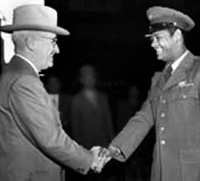
War Manpower Commission
Alexander Liberman Photo
Source: National Archives
The move toward desegregation that had been encouraged by the non-violent protests during World War II would continue after the War as the military evaluated the role of blacks and the need for continued segregation. President Truman's attention was drawn to the problem of the treatment of blacks by violence against returning members of the military, particularly an attack on Sergeant Isaac Woodard, who was attacked on a bus while going home to North Carolina in uniform, beaten, and left blind. Truman appointed the President's Committee on Civil Rights in December 1946; the committee would recommend in October 1947 that the military be completely desegregated. By this time, it was clear that the desegregation that had occurred over the course of World War II had not led to the kind of problems or disruptions that the military had feared.1

Truman greets Airman, 1950
Source: Truman LIbrary
